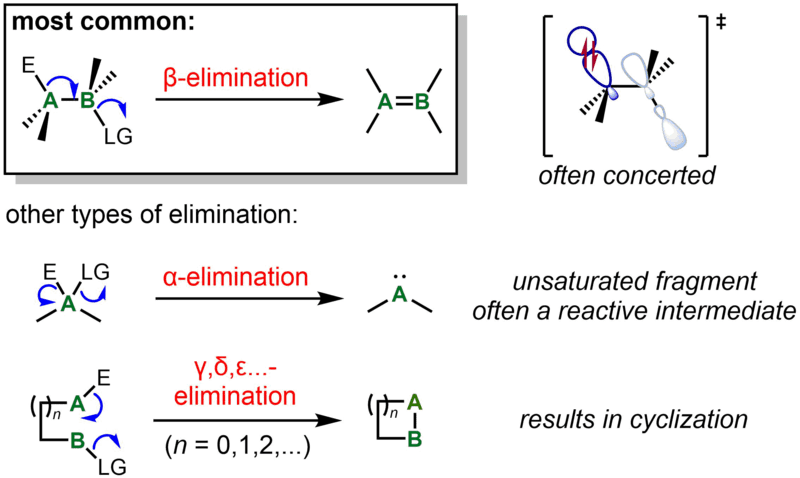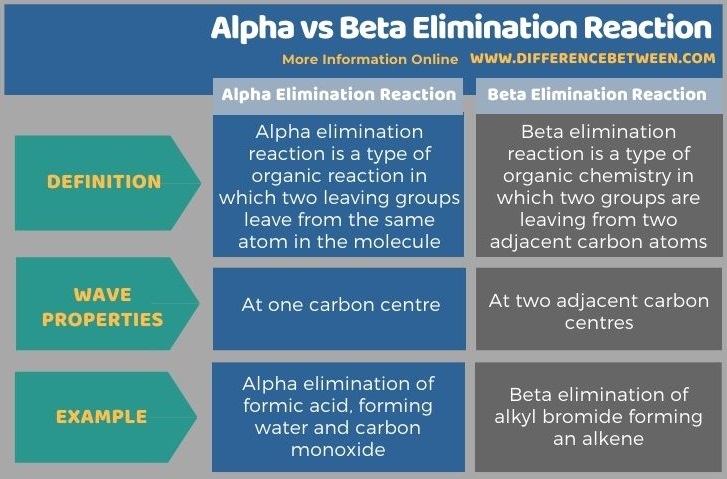Difference Between Alpha and Beta Elimination Reaction
The key difference between alpha and beta elimination reaction is that in alpha elimination reaction, two leaving groups leave from the same atom whereas, in beta elimination reaction, the two leaving groups leave from two adjacent atoms of the same molecule.
Elimination reaction is a type of organic reaction in which two substituents are removed from a molecule. This removal is done either in a single step reaction or in a two-step mechanism. The single-step mechanism is denoted as an E2 reaction while the two-step mechanism is denoted as E1 reaction. In these denotations, the number that comes with the letter E refers to the kinetics of the reaction, e.g. E2 reactions are bimolecular reactions (second-order) while E1 reactions are unimolecular reactions (first-order). In addition to that, there are two types of elimination reactions named as alpha elimination and beta elimination, the latter being the most common elimination reaction type.
CONTENTS
1. Overview and Key Difference
2. What is an Alpha Elimination Reaction
3. What is a Beta Elimination Reaction
4. Side by Side Comparison – Alpha vs Beta Elimination Reaction in Tabular Form
5. Summary
What is an Alpha Elimination Reaction?
Alpha elimination reaction is a type of organic reaction in which two leaving groups leave from the same atom in the molecule. It is the second most common type of elimination reaction and is denoted by α–elimination. When there is a carbon centre in the molecule that undergoes the elimination reaction, the final result is the formation of a carbene, which includes stable carbenes such as carbon monoxide and isocyanides. For example, alpha elimination of chloroform molecule, CHCl3, in the presence of a strong base gives dichlorocarbene along with HCl as the eliminating compound or the leaving group. In this reaction, there is one carbon centre containing three chlorine atoms and a hydrogen atom attached to it. Elimination occurs at this one carbon atom; leaving groups are hydrogen atom and one chlorine atom.

Figure 01: Examples of Alpha and Beta Elimination Reactions
Similarly, formic acid also can undergo alpha elimination. The stable products of this elimination reaction include water and carbon monoxide in the presence of an acidic condition. Moreover, an alpha elimination can occur in a metal centre, which can lead to the lowering of the metal oxidation state and the coordination number by 2 units. Hence, this type of reaction is named as reductive elimination.
What is a Beta Elimination Reaction?
Beta elimination reaction is a type of organic chemistry in which two groups leave from two adjacent carbon atoms. In other words, beta elimination is the loss of electrofuge and nucleofuge on vicinal carbons. This is the most common type of elimination reaction in organic chemistry.
As the end product of this reaction, beta elimination forms a product containing C=C and C=X bonds. When considering the stability of the final product and orbital alignment, the beta elimination reaction is strongly favourable than other types of elimination reactions. However, there are other types such as alpha elimination and gamma elimination for the systems that do not favour the alpha elimination.
What is the Difference Between Alpha and Beta Elimination Reaction?
Alpha and beta elimination are two types of organic chemical reactions. The key difference between alpha and beta elimination reaction is that in alpha elimination reaction, two leaving groups leave from the same atom whereas, in beta elimination reaction, the two leaving groups leave from two adjacent atoms of the same molecule.
Below infographic tabulates the differences between alpha and beta elimination reaction in more detail.

Summary – Alpha vs Beta Elimination Reaction
Alpha and beta elimination are two types of organic chemical reactions. The key difference between alpha and beta elimination reaction is that in alpha elimination reaction, two leaving groups leave from the same atom whereas, in beta elimination reaction, the two leaving groups leave from two adjacent atoms of the same molecule.
Reference:
1. “β-Elimination Reactions.” Chemistry LibreTexts, Libretexts, 15 Aug. 2020, Available here.
2. “1,1-Elimination.” Chemistry LibreTexts, Libretexts, 24 Aug. 2020, Available here.
3. “Elimination Reaction.” Wikipedia, Wikimedia Foundation, 21 Sept. 2020, Available here.
Image Courtesy:
1. “Eliminationrxns” By Alsosaid1987 – Own work (CC BY-SA 4.0) via Commons Wikimedia
ncG1vNJzZmivp6x7pbXFn5yrnZ6YsqOx07CcnqZemLyue8OinZ%2Bdopq7pLGMm5ytr5Wau26ty6mfmmWRo7FursStmGadnJ66qrrAraCopl2nsqKv06Kmp2c%3D